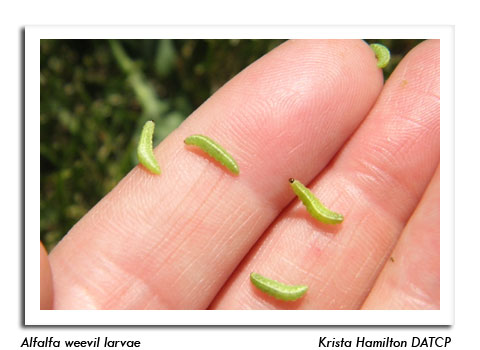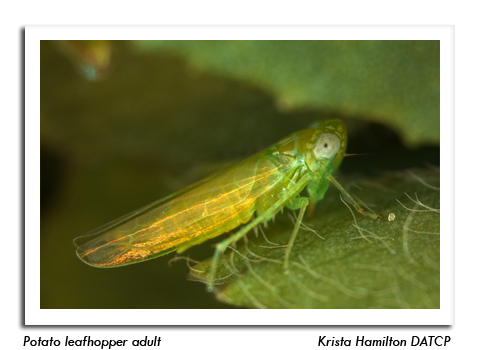
 |
|
|
Forages & Grains
Volume 65 Number 18 Date 11/12/2020 POTATO LEAFHOPPER - Alfalfa surveys found markedly lower leafhopper pressure this season compared to 2019. The first distinct migration occurred during the week of May 17 and nymphs appeared in second-crop alfalfa by June 22. The July monthly average count in 120 alfalfa fields sampled was 1.05 per sweep, significantly lower than the 2.04 average in 2019. Above-threshold counts (>2.0 per sweep) were recorded at 20% of sites compared to 47% last year. A few fruit and vegetable growers noted carryover of leafhoppers into other crops as hay was harvested in July and August, but severe damage to alfalfa, fruit trees, nursery plants, and vegetables was not reported. ALFALFA WEEVIL - Counts in first-crop alfalfa were low in 2020. The first appearance of larvae was later than average and began in southern Wisconsin by May 22. Peak weevil feeding was predicted for June 11-24 across much of the state. Sweep net counts remained low (<1.0 per sweep) through late June, while leaf tip damage estimates did not exceed the 40% economic threshold in any surveyed field. The larval feeding window closed by early July without significant defoliation observed this year. INDUSTRIAL HEMP PESTS HEMP PESTS - DATCP hemp inspectors conducted the state's first official industrial hemp pest survey in 2020, documenting the prevalence of five leading hemp insects and diseases: Eurasian hemp borer, European corn borer, gray mold, leaf spot, and white mold. Inspectors recorded pest observations at 991 distinct locations in 70 counties. Eurasian hemp borer (EHB), thought to be the most common and destructive hemp pest insect in the state, was found at 13% of the sites. Ten percent of those sites had light infestations impacting 1-10% of the plants, 2% had moderate infestations affecting 11-49% of the plants, and 1% had severe infestations (>50% of the plants). The highest EHB pressure was observed in Dane, La Crosse, Lafayette and Sauk counties. Dane County had the most fields with EHB infestations rated as severe. Inspectors also looked for signs of European corn borer (ECB), which was found at 5% of the sites this season. ECB pressure was low overall. Only two locations, one each in Dane and La Crosse counties, had heavy ECB populations affecting >50% of plants. Of the three disease targets, hemp leaf spot was by far the most prevalent. Inspectors noted leaf spot symptoms at 41% of sites, followed by white mold in 7%, and gray mold at 2% of the sites. Hemp leaf spot was largely mild, with 30% of fields rated as having light symptoms, 8% having moderate symptoms and 4% having severe symptoms (>50% of plants). -- Krista Hamilton, DATCP Entomologist 

.jpg)
.jpg)
.jpg)

|
|
|